Numerical Analysis of Water–Sediment Flow Fields within the Intake Structure of Pumping Station under Different Hydraulic Conditions
Abstract
:1. Introduction
2. Field Test
2.1. Study Area
2.2. Measurement of the In Situ Flow Field
2.3. Acquisition and Processing of Point Cloud Data
3. Construction and Validation of the Numerical Model
3.1. Governing Equation and Solving Method
3.2. Boundary Condition and Meshing
3.3. Verification of Numerical Model
4. Results and Discussion
4.1. Calculated Working Conditions
4.2. Effect of Sediment on the Flow Field
4.3. Effect of Sediment Concentration on the Flow Field
4.4. Effect of Flow Rate on Flow Field
5. Conclusions
- (1)
- The reverse-modeling method proposed and applied in this study can accurately identify the actual structure of the research object and the morphology of sediment deposition. Moreover, the quantitative verification of the numerical simulation results using field experimental values is more reliable. It not only provides a foundation for subsequent hydraulic analysis but also offers an effective reference for the modeling of similar projects with complex morphology.
- (2)
- At the solid-phase particle size of 25 μm and mass concentration of 30 kg/m3, the sediment will cause the coaxial vortex to evolve into a larger-scale spiral vortex along the water depth direction, and the backflow zone accounts for about 2/3 of the intake structure volume. The process of sediment deposition is controlled by the range, intensity, and flow velocity of the vortex backflow zone, and the maximum volume fraction of the near-bottom sediment increases by 202.01% compared to the initial state, especially in the suction sump. Sediment deposition is mainly distributed in areas with flow velocities below 0.100 m/s, and the vortex backflow zone is more prominent. With the increase in the sediment concentration, the attenuation of flow velocity will be accelerated. Although it assists in the diffusion of water flow, the increase in the sediment concentration and the decrease in flow velocity will further worsen the problem of sediment deposition. Increasing the flow rate will lead to an increase in the flow velocity within the intake structure, exacerbating the turbulence of the flow field.
- (3)
- The sediment-laden water source is the fundamental cause of sediment deposition in the intake structure, and the adverse flow fields, such as low-velocity zones and vortex backflow zones, have a significant promoting effect on the sediment deposition process, which is the main reason for its functional decline and sediment deposition. The improvement effect of adjusting the flow rate and start-up combination is relatively weak. Thus, subsequent research on optimization of the structural parameters and engineering measures should be carried out, such as adjusting the diffusion angle, length–width ratio, and bottom longitudinal slope, as well as parameters such as the submergence depth, suspension height, and rear wall distance of the suction pipe. Research could also examine the utility of setting up a debris basin, diversion pier, bottom sill, water-entrapment plate, vortex-elimination device, etc. The sediment particle size is also a non-negligible influencing factor, which should be considered in follow-up to improve the research content. In addition, the critical conditions for the deposition and start-up of sediment at the bottom should also be further analyzed.
Author Contributions
Funding
Data Availability Statement
Acknowledgments
Conflicts of Interest
References
- Wang, Z.; Qian, Z. Effects of concentration and size of silt particles on the performance of a double-suction centrifugal pump. Energy 2017, 123, 36–46. [Google Scholar] [CrossRef]
- Wang, H.; Li, C.; Lu, S.; Song, L. The flow patterns and sediment deposition in the forebay of a forward-intake pumping station. Phys. Fluids 2022, 34, 083316. [Google Scholar] [CrossRef]
- Wang, C.; Wang, F.; Chen, W.; He, Q.; Chen, X.; Zhang, Z. A dynamic particle scale-driven interphase force model for water-sand two-phase flow in hydraulic machinery and systems. Int. J. Heat Fluid Flow 2022, 95, 108974. [Google Scholar] [CrossRef]
- Rogallo, R.S.; Moin, P. Numerical simulation of turbulent flows. Annu. Rev. Fluid Mech. 1984, 16, 99–137. [Google Scholar] [CrossRef]
- Crowe, C.T.; Troutt, T.R.; Chung, J.N. Numerical models for two-phase turbulent flows. Annu. Rev. Fluid Mech. 1996, 28, 11–43. [Google Scholar] [CrossRef]
- Bernard, P.; Wallace, J.; Yavuzkurt, S. Turbulent flow: Analysis, measurement, and prediction. J. Fluid Mech. 2002, 478, 344–345. [Google Scholar] [CrossRef]
- Tu, Y.; Yeoh, G.H.; Liu, C. Computational Fluid Dynamics—A Practical Approach, 2nd ed.; Elsevier: Oxford, UK, 2013. [Google Scholar]
- Ansar, M.; Nakato, T. Experimental study of 3D pump-intake flows with and without cross flow. J. Hydraul. Eng. 2001, 127, 825–834. [Google Scholar] [CrossRef]
- Aubin, J.; Fletcher, D.F.; Xuereb, C. Modeling turbulent flow in stirred tanks with CFD: The influence of the modeling approach, turbulence model and numerical scheme. Exp. Therm. Fluid Sci. 2004, 28, 431–445. [Google Scholar] [CrossRef]
- Chen, H.-x.; Guo, J.-h. Numerical simulation of 3-D turbulent flow in the multi-intakes sump of the pump station. J. Hydrodyn. 2007, 19, 42–47. [Google Scholar] [CrossRef]
- Zi, D.; Wang, F.; Yao, Z.; Hou, Y.; Yang, E. Effects analysis on rectifying intake flow field for large scale pumping station with combined diversion piers. Nongye Gongcheng Xuebao Trans. Chin. Soc. Agric. Eng. 2015, 31, 71–77. [Google Scholar]
- Zi, D.; Wang, F.; Tao, R.; Hou, Y. Research for impacts of boundary layer grid scale on flow field simulation results in pumping station. J. Hydraul. Eng. 2016, 47, 139–149. [Google Scholar]
- Zi, D.; Wang, B.; Wang, F.; He, C.; Xue, S. Influences of start-up pump units on the sediment concentration for the intake system of a pumping station. Trans. Chin. Soc. Agric. Eng. 2022, 38, 59–68. [Google Scholar]
- Gao, X.; Tian, Y.; Sun, B. Multi-objective optimization design of bidirectional flow passage components using RSM and NSGA II: A case study of inlet/outlet diffusion segment in pumped storage power station. Renew. Energy 2017, 115, 999–1013. [Google Scholar] [CrossRef]
- Balachandar, S.; Eaton, J.K. Turbulent dispersed multiphase flow. Annu. Rev. Fluid Mech. 2010, 42, 111–133. [Google Scholar] [CrossRef]
- Li, L.; Xu, W.; Tan, Y.; Yang, Y.; Yang, J.; Tan, D. Fluid-induced vibration evolution mechanism of multiphase free sink vortex and the multi-source vibration sensing method. Mech. Syst. Signal Process. 2023, 189, 110058. [Google Scholar] [CrossRef]
- Song, X.; Wang, Z.; Saksala, T.; Borisov, V.G.; Zakharov, Y.N.; Shokin, Y.I.; Ovcharenko, E.A.; Klyshnikov, K.Y.; Ren, Z.; Wan, D. Numerical prediction of the effect of free surface vortex air-entrainment on sediment erosion in a pump. Proc. Inst. Mech. Eng. Part A J. Power Energy 2022, 236, 1297–1308. [Google Scholar] [CrossRef]
- Hou, X.; Yuan, J.; Fu, Y.; Lu, R.; Shi, J.; Zhang, P. A study on the dynamic characteristics of surface suction vortices in an open inlet pool. Phys. Fluids 2023, 35, 065108. [Google Scholar] [CrossRef]
- Xu, C.; Li, J.; Wang, R.; Tian, J.; Liu, Z.; Wang, Y.; Xu, X. Study on the influence of the start-up combinations on the characteristics of the water-sediment flow field in forebay of pumping station. J. Hohai Univ. Nat. Sci. 2022, 50, 11–16. [Google Scholar]
- Xu, C.; Wang, R.; Liu, H.; Lian, H.; Wang, Y.; Wang, G. Research on the influence of start-up combinations on the flow pattern in forebay of side-inlet pumping station on sandy river. J. Hydraul. Eng. 2020, 51, 92–101. [Google Scholar]
- Xu, C.; Tian, J.; Liu, Z.; Wang, R.; Wang, G. Three-dimensional reverse modeling and hydraulic analysis of the intake structure of pumping stations on sediment-laden rivers. Water Resour. Manag. 2023, 37, 537–555. [Google Scholar] [CrossRef]
- Li, X.; Chen, H.; Chen, B.; Luo, X.; Yang, B.; Zhu, Z. Investigation of flow pattern and hydraulic performance of a centrifugal pump impeller through the PIV method. Renew. Energy 2020, 162, 561–574. [Google Scholar] [CrossRef]
- Li, W.; Zhou, L.; Shi, W.-d.; Ji, L.; Yang, Y.; Zhao, X. PIV experiment of the unsteady flow field in mixed-flow pump under part loading condition. Exp. Therm. Fluid Sci. 2017, 83, 191–199. [Google Scholar] [CrossRef]
- Song, Q.; Sun, B.; Gao, X.; Zhang, C. PIV experimental investigation of the outflow temperature from nonlinearly stratified reservoir regulated by floating intake. Exp. Therm. Fluid Sci. 2019, 109, 109893. [Google Scholar] [CrossRef]
- Song, X.; Liu, C. Experimental study of the floor-attached vortices in pump sump using V3V. Renew. Energy 2021, 164, 752–766. [Google Scholar] [CrossRef]
- Zhang, B.; Yang, A.; Cheng, L.; Jiao, W.; Chen, Y.; Zhao, H. Spatial-temporal evolution and pressure fluctuation characteristics of the combined submerged vortex in a closed pump sump. Phys. Fluids 2023, 35, 065140. [Google Scholar] [CrossRef]
- Gao, M.; Cheng, L. Study on cascade density of the impeller based on response surface analysis. Water 2023, 15, 4101. [Google Scholar] [CrossRef]
- Zheng, X.; Zhang, P.; Zhang, W.; Yu, Y.; Zhao, Y. Numerical study on the influence of combined rectification facilities on the flow in the forebay of fumping station. Water 2023, 15, 3847. [Google Scholar] [CrossRef]
- Nasr, A.; Yang, F.; Zhang, Y.; Wang, T.; Hassan, M. Analysis of the flow pattern and flow rectification measures of the side-intake forebay in a multi-unit pumping station. Water 2021, 13, 2025. [Google Scholar] [CrossRef]
- Muramatsu, E.; Murakawa, H.; Hashiguchi, D.; Sugimoto, K.; Asano, H.; Wada, S.; Furuichi, N. Applicability of hybrid ultrasonic flow meter for wide-range flow-rate under distorted velocity profile conditions. Exp. Therm. Fluid Sci. 2018, 94, 49–58. [Google Scholar] [CrossRef]
- Tan, C.; Murai, Y.; Liu, W.; Tasaka, Y.; Dong, F.; Takeda, Y. Ultrasonic doppler technique for application to multiphase flows: A review. Int. J. Multiph. Flow 2021, 144, 103811. [Google Scholar] [CrossRef]
- Wang, H. The Study of the Key Techniques in the Realization of Integrated Engineering Survey System in South-to-North Water Diversion Project. Ph.D. Thesis, Wuhan University, Wuhan, China, 2016. [Google Scholar]
- Trebuňa, P.; Mizerák, M.; Trojan, J.; Rosocha, L.J.A.T. 3D scanning as a modern technology for creating 3D models. Acta Tecnol 2020, 6, 21–24. [Google Scholar] [CrossRef]
- Aryan, A.; Bosche, F.; Tang, P. Planning for terrestrial laser scanning in construction: A review. Autom. Constr. 2021, 125, 103551. [Google Scholar] [CrossRef]
- Dimas, E.; Briassoulis, D. 3D geometric modelling based on NURBS: A review. Adv. Eng. Softw. 1999, 30, 741–751. [Google Scholar] [CrossRef]
- Park, H. An approximate lofting approach for B-spline surface fitting to functional surfaces. Int. J. Adv. Manuf. Technol. 2001, 18, 474–482. [Google Scholar] [CrossRef]
- Date, A.W. Introduction to Computational Fluid Dynamics; Cambridge University Press: Cambridge, UK, 2005; pp. 273–283. [Google Scholar]
- Versteeg, H.K.; Malalasekera, W. An Introduction to Computational Fluid Dynamics; Pearson Schweiz Ag: Cham, Switzerland, 2007; Volume 20, 400p. [Google Scholar]
- Ansys Inc. ANSYS Fluent Theory Guide; Ansys Inc.: Canonsburg, PA, USA, 2013. [Google Scholar]
- Manninen, M.; Taivassalo, V.; Kallio, S. Mixture Model for Multiphase Flow; Technical Report VTT-PUB-288; Technical Research Centre of Finland: Espoo, Finland, 1996. [Google Scholar]
- Wulf, A.; Akdag, V. Tuned grid generation with ICEM CFD. In Surface Modeling Grig Generation, and Related Issues in Computational Fluid Dynamic (CFD) Solutions; NASA: Washington, DC, USA, 1995. [Google Scholar]
- Hodson, T.O. Root-mean-square error (RMSE) or mean absolute error (MAE): When to use them or not. Geosci. Model Dev. 2022, 15, 5481–5487. [Google Scholar] [CrossRef]
- Karunasingha, D.S.K. Root mean square error or mean absolute error? Use their ratio as well. Inf. Sci. 2022, 585, 609–629. [Google Scholar] [CrossRef]


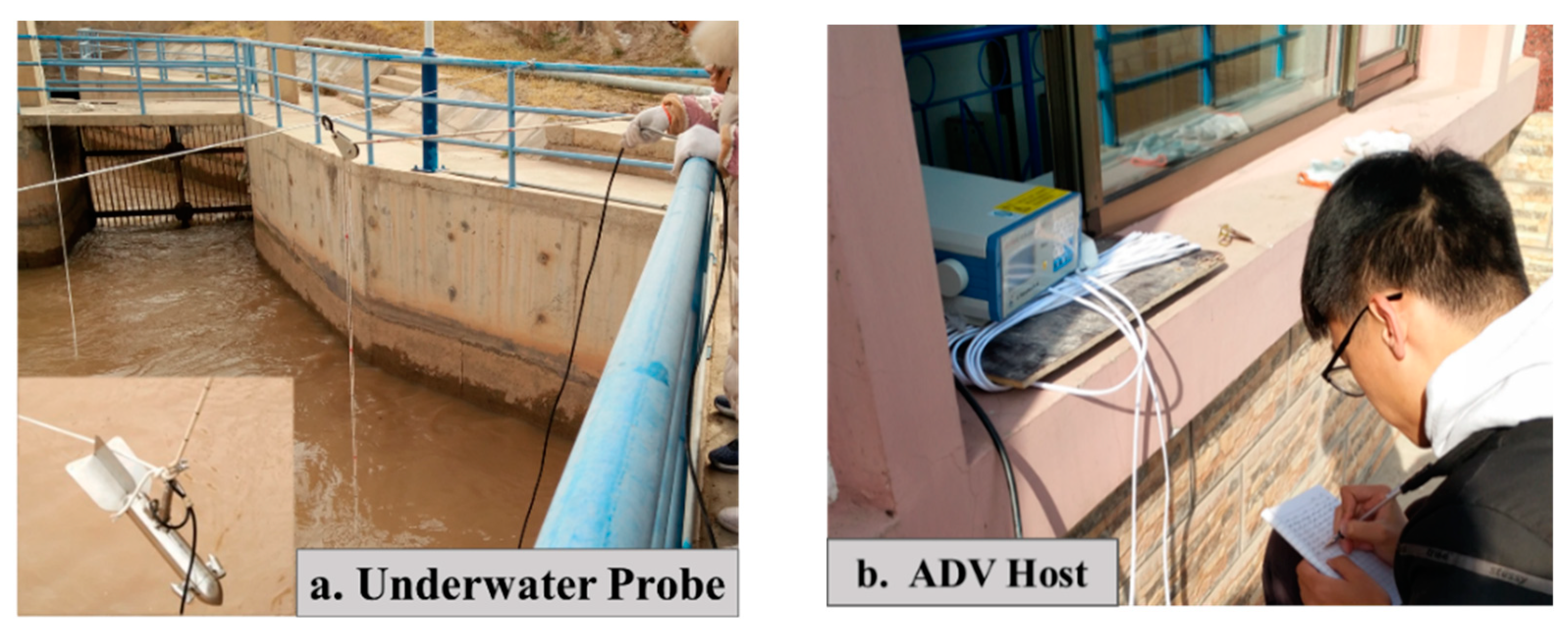
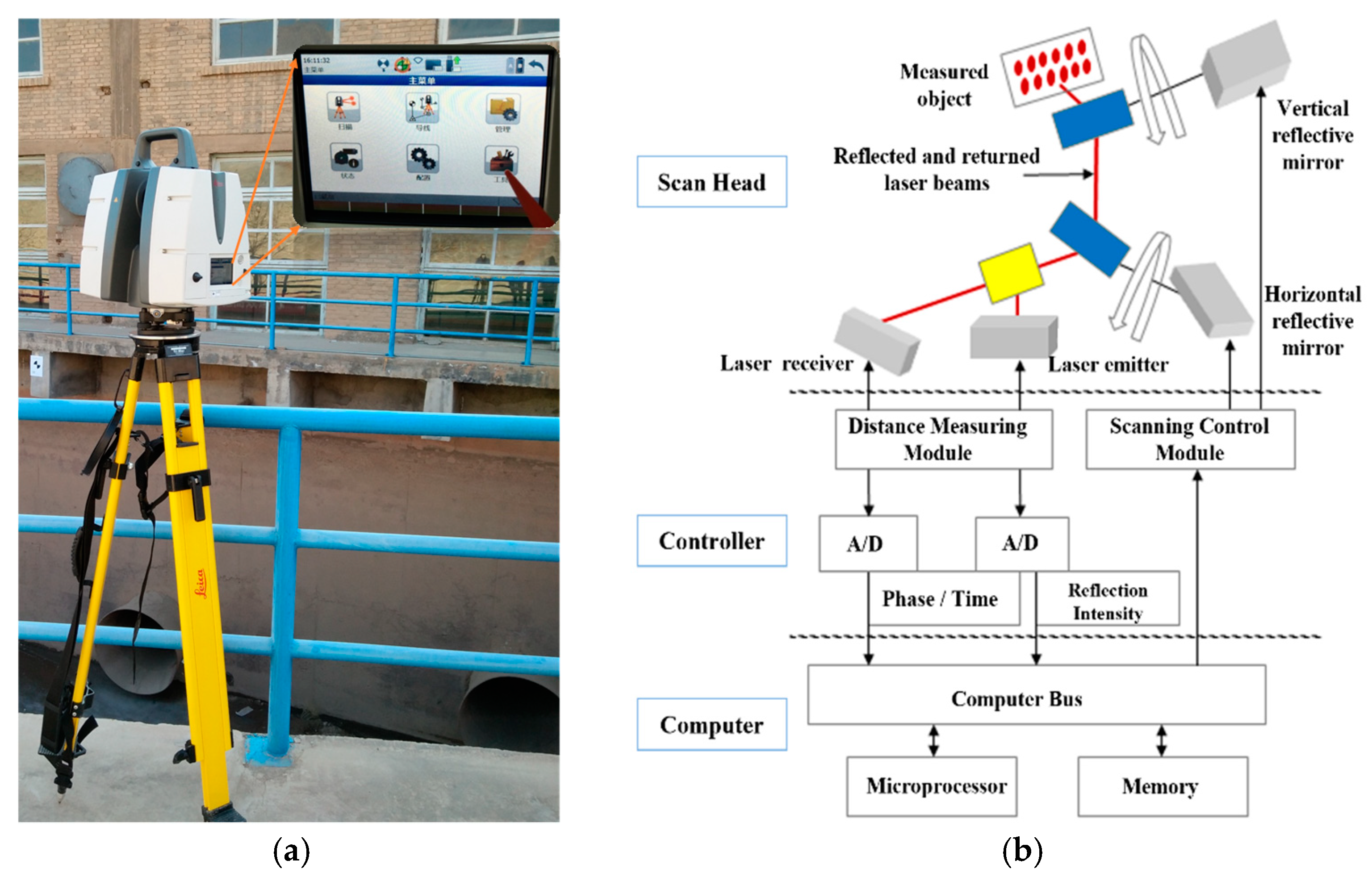
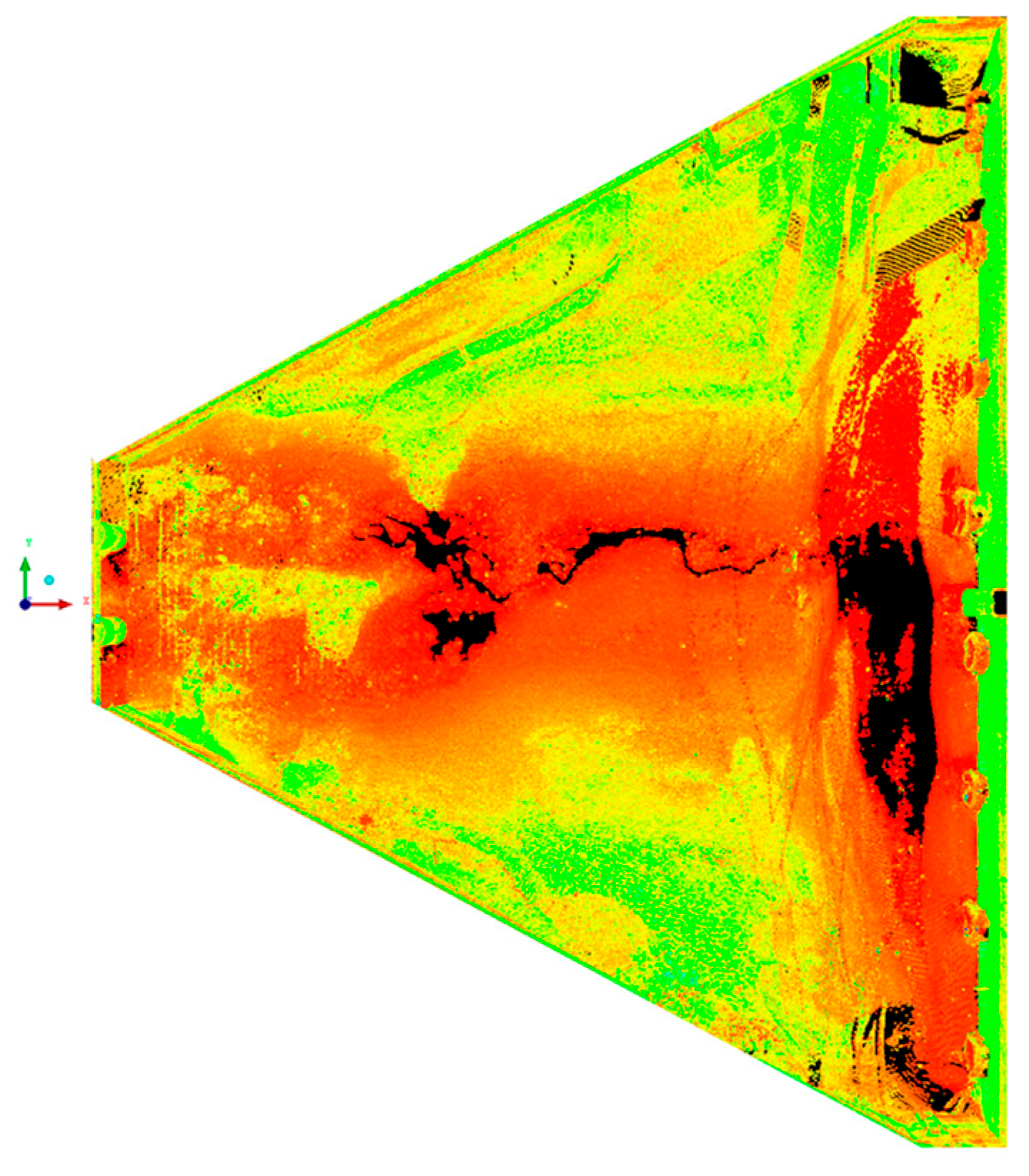

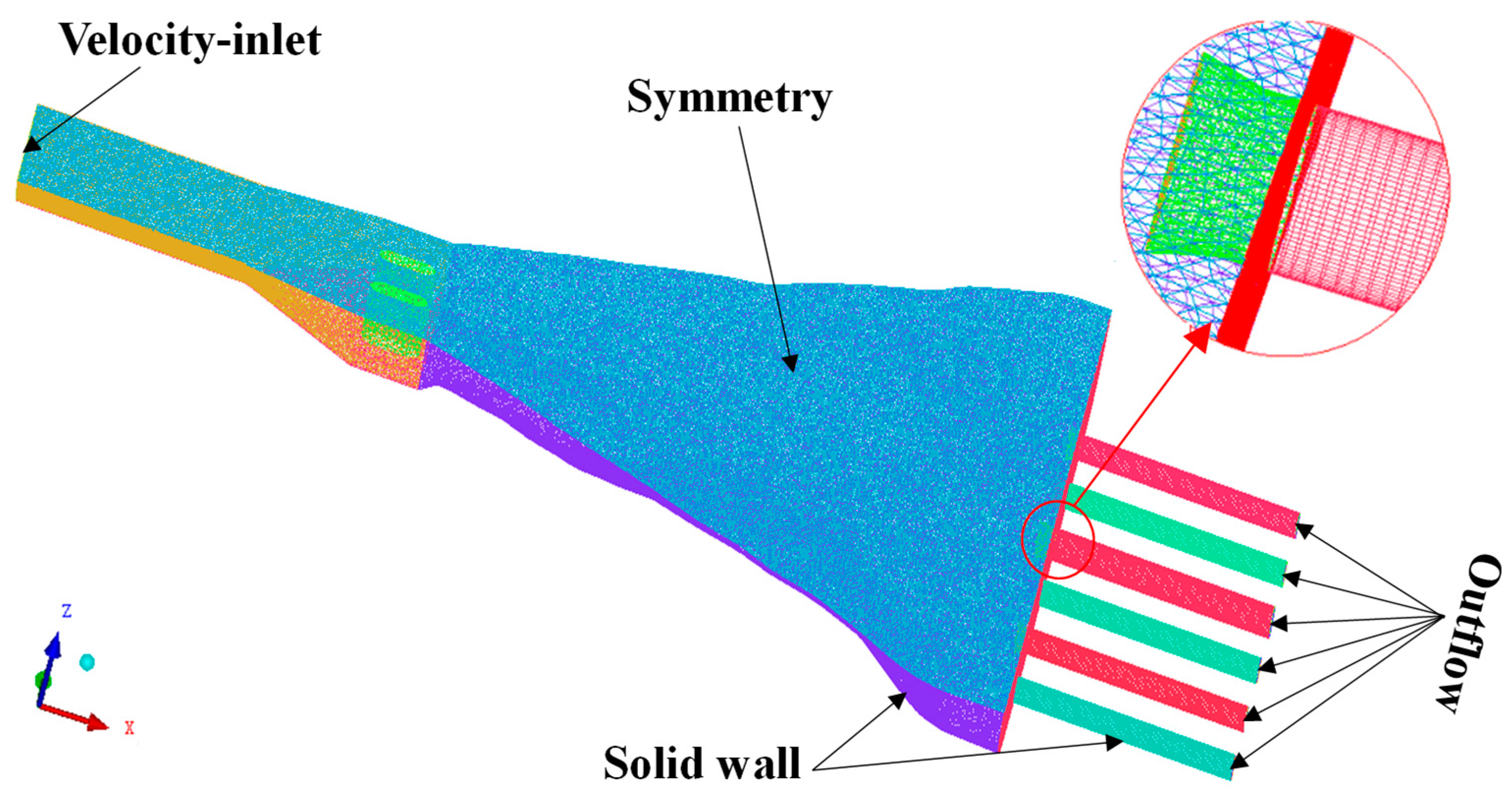
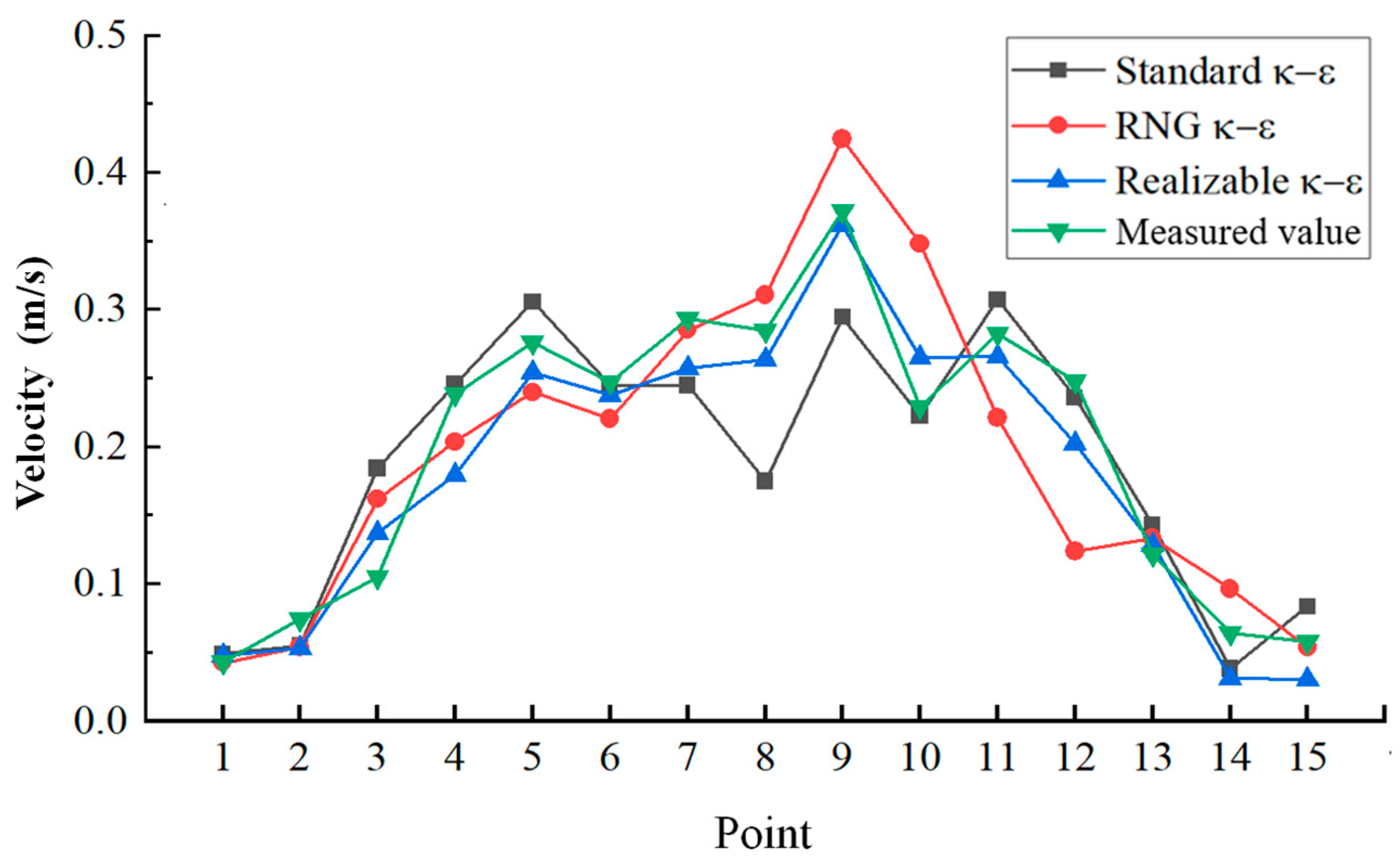
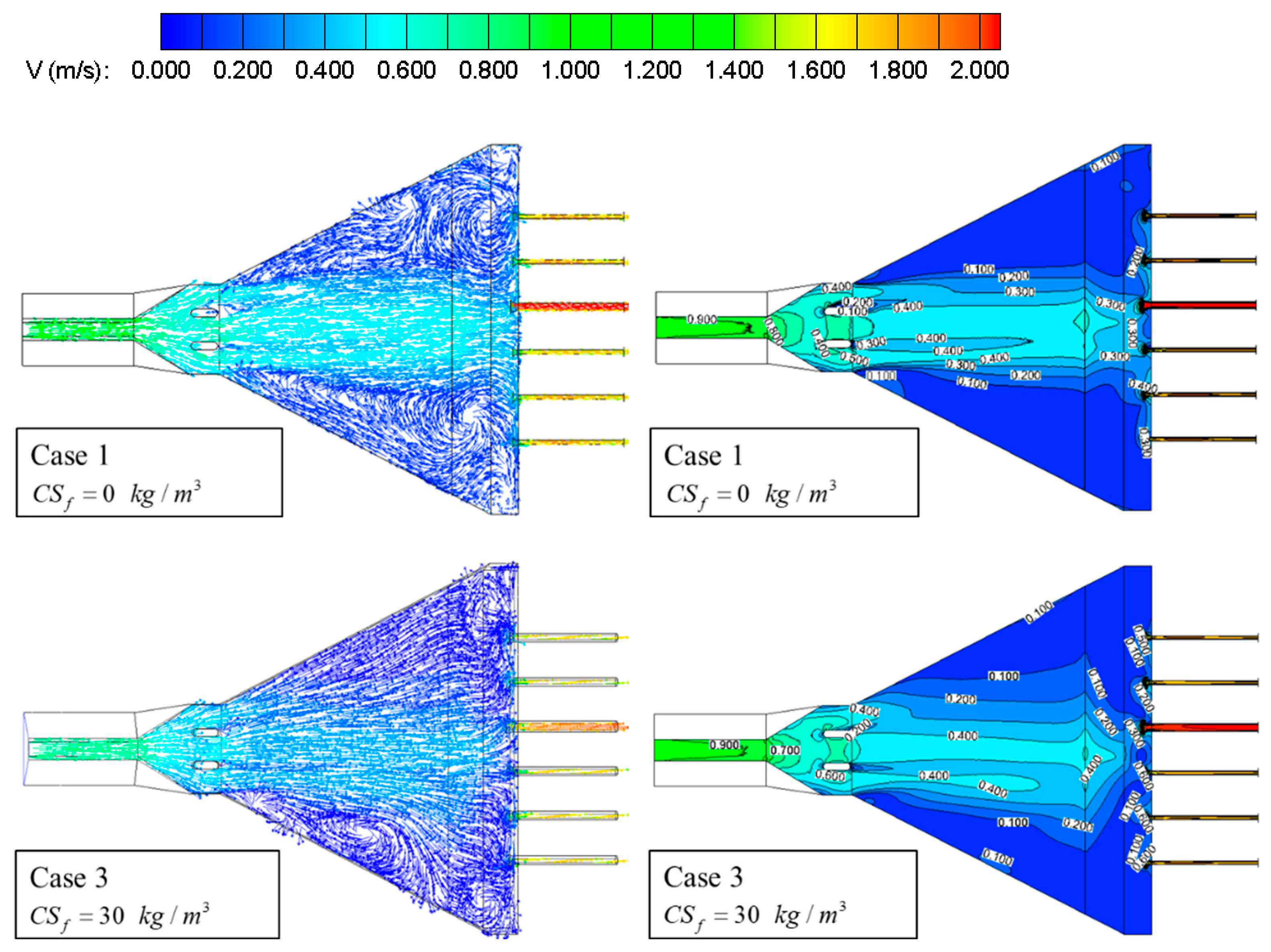

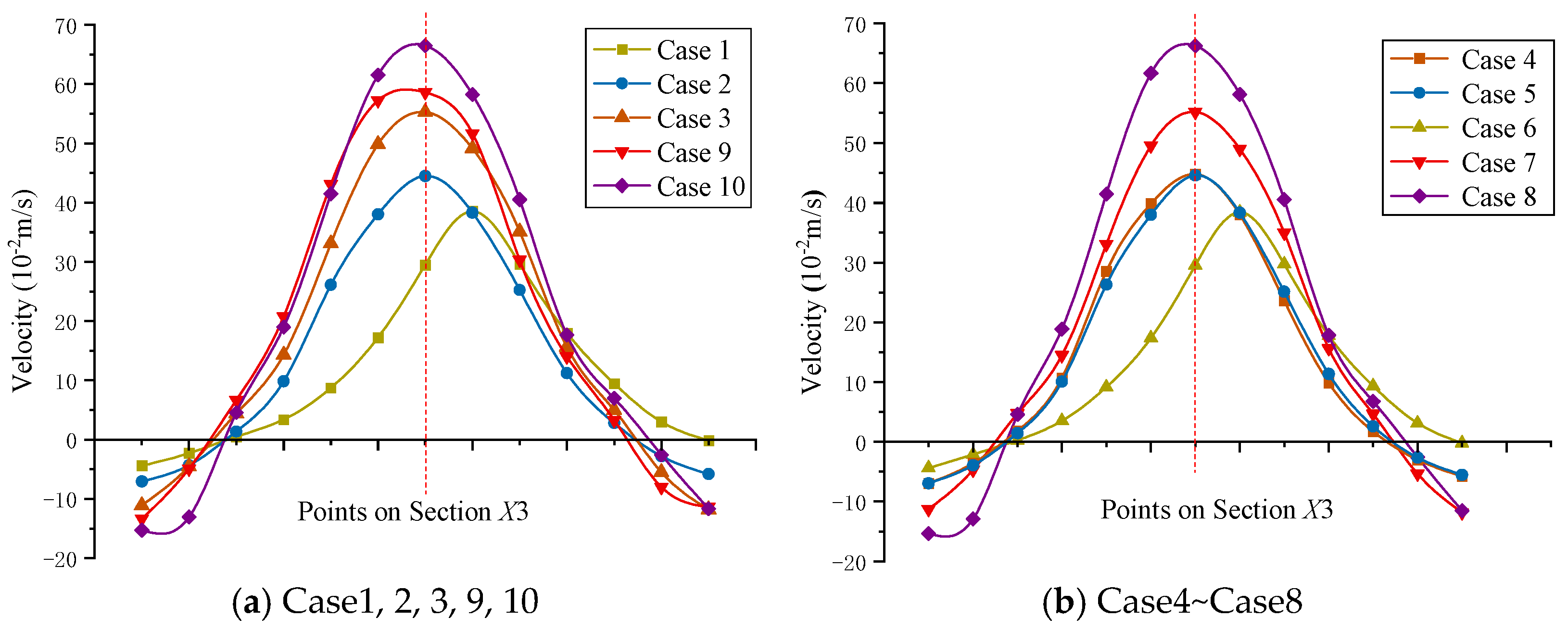

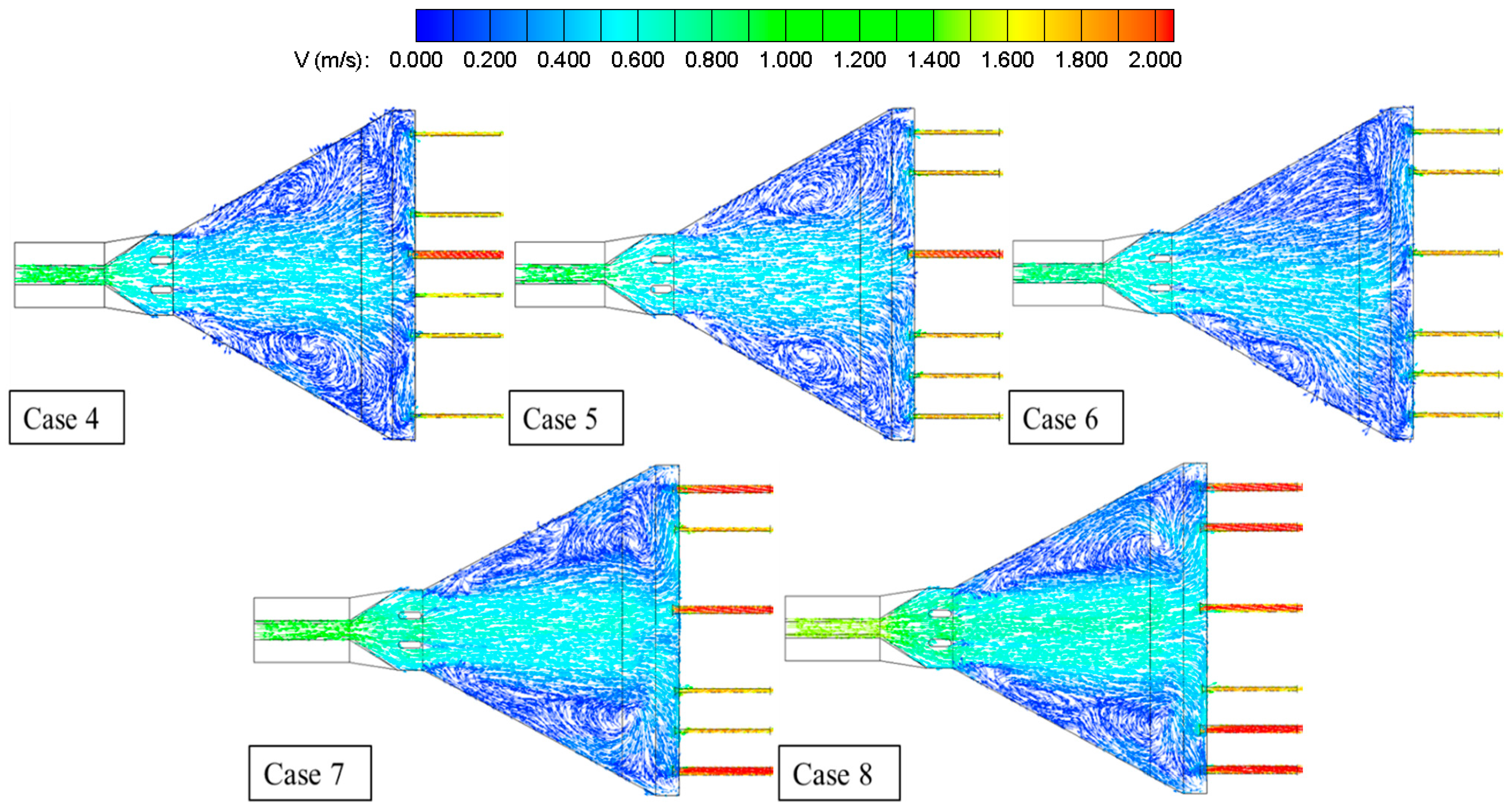
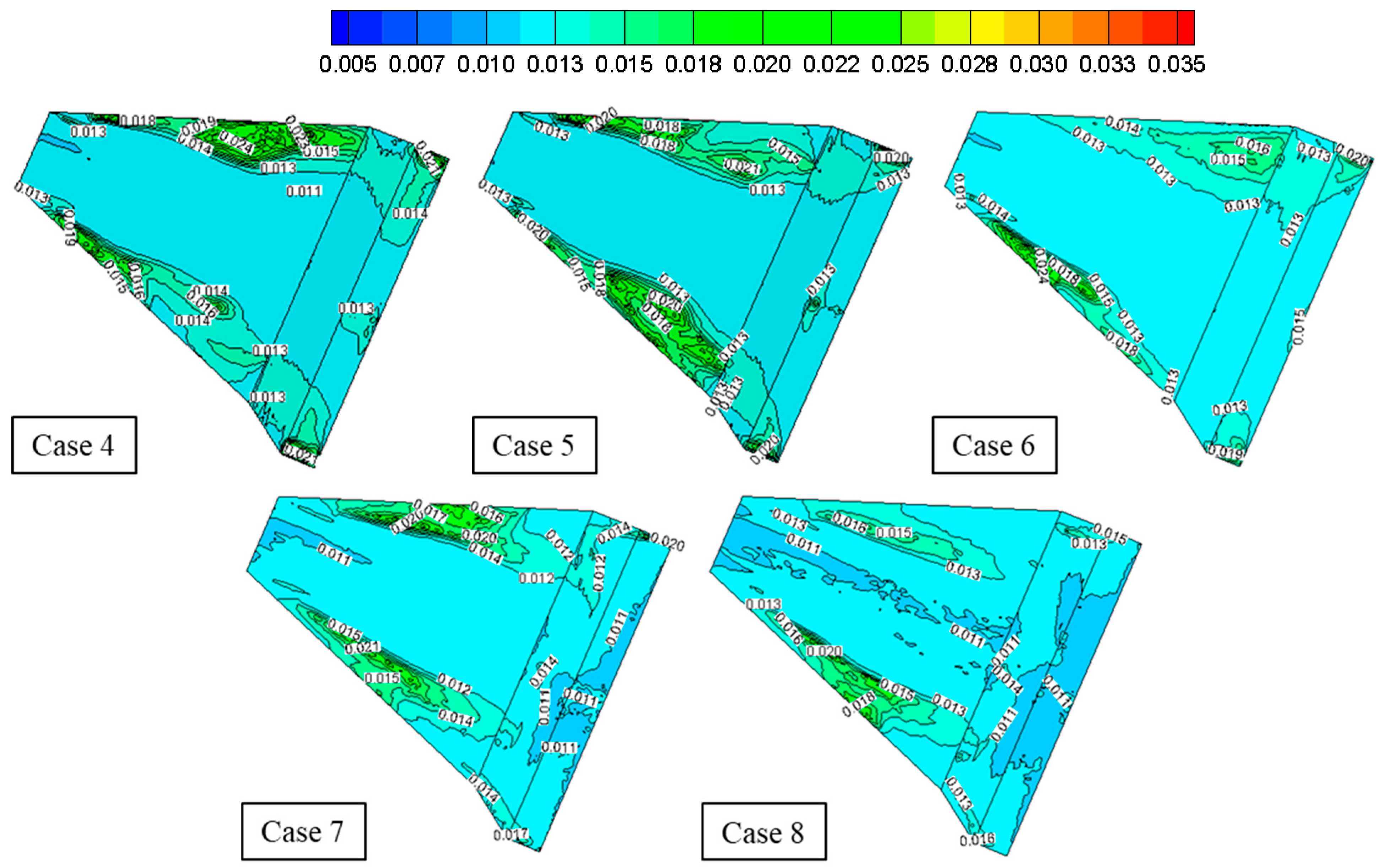
| Sieve Hole Size (μm) | Sieve Residue (%) | Cumulative Sieve Residue (%) |
|---|---|---|
| 600 | 0 | 0 |
| 300 | 0 | 0 |
| 150 | 0.01 | 0.01 |
| 125 | 0.03 | 0.04 |
| 90 | 1.23 | 1.27 |
| 75 | 4.82 | 6.09 |
| 63 | 5.87 | 11.66 |
| 45 | 6.29 | 21.35 |
| Sieve bottom | 81.75 | 100 |
| No. | CSf (kg/m3) | Q (m3/s) | Operation Combination |
|---|---|---|---|
| Case1 | 0 | 6.0 | #5 (1.6 m3/s); #2, 3, 4, 6, 7 (0.88 m3/s) |
| Case2 | 15 | 6.0 | Same as case1 |
| Case3 | 30 | 6.0 | Same as case1 |
| Case4 | 30 | 6.0 | #5 (1.6 m³/s); #1, 3, 4, 6, 8 (0.88 m3/s) |
| Case5 | 30 | 6.0 | #5 (1.6 m³/s); #1, 2, 3, 7, 8 (0.88 m3/s) |
| Case6 | 30 | 5.28 | #1, 2, 3, 5, 7, 8# (0.88 m3/s) |
| Case7 | 30 | 7.44 | #2, 3, 7 (0.88 m3/s); #1, 5, 8 (1.6 m³/s) |
| Case8 | 30 | 8.88 | #3 (0.88 m³/s); #1, 2, 5, 7, 8 (1.6 m³/s) |
| Case9 | 50 | 6.0 | Same as case1 |
| Case10 | 70 | 6.0 | Same as case1 |
Disclaimer/Publisher’s Note: The statements, opinions and data contained in all publications are solely those of the individual author(s) and contributor(s) and not of MDPI and/or the editor(s). MDPI and/or the editor(s) disclaim responsibility for any injury to people or property resulting from any ideas, methods, instructions or products referred to in the content. |
© 2024 by the authors. Licensee MDPI, Basel, Switzerland. This article is an open access article distributed under the terms and conditions of the Creative Commons Attribution (CC BY) license (https://creativecommons.org/licenses/by/4.0/).
Share and Cite
Xu, C.; Tian, J.; Wang, G.; Lian, H.; Wang, R.; Hu, X. Numerical Analysis of Water–Sediment Flow Fields within the Intake Structure of Pumping Station under Different Hydraulic Conditions. Water 2024, 16, 779. https://doi.org/10.3390/w16050779
Xu C, Tian J, Wang G, Lian H, Wang R, Hu X. Numerical Analysis of Water–Sediment Flow Fields within the Intake Structure of Pumping Station under Different Hydraulic Conditions. Water. 2024; 16(5):779. https://doi.org/10.3390/w16050779
Chicago/Turabian StyleXu, Cundong, Junjiao Tian, Guoxia Wang, Haidong Lian, Rongrong Wang, and Xiaomeng Hu. 2024. "Numerical Analysis of Water–Sediment Flow Fields within the Intake Structure of Pumping Station under Different Hydraulic Conditions" Water 16, no. 5: 779. https://doi.org/10.3390/w16050779






